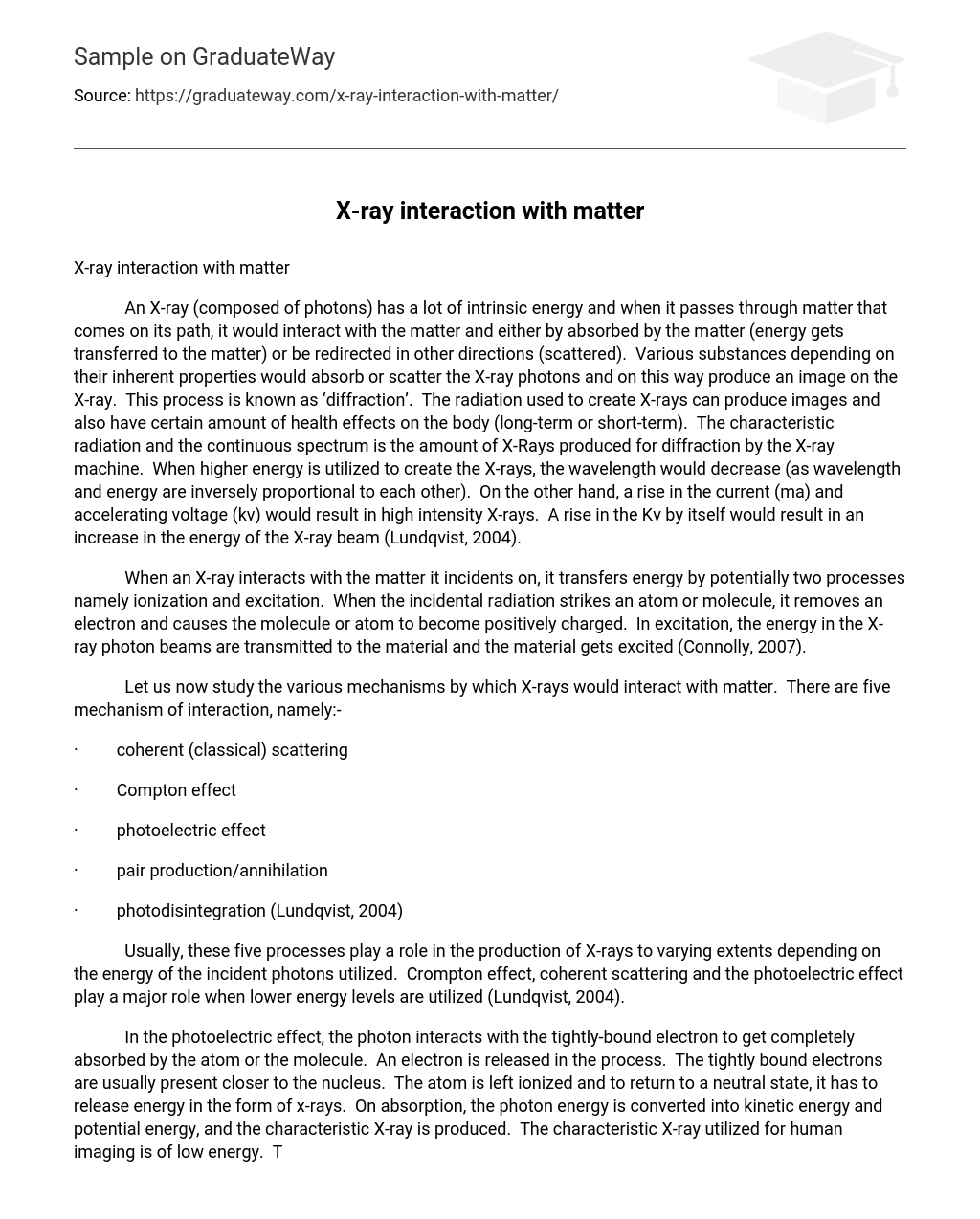An X-ray (composed of photons) has a lot of intrinsic energy and when it passes through matter that comes on its path, it would interact with the matter and either by absorbed by the matter (energy gets transferred to the matter) or be redirected in other directions (scattered). Various substances depending on their inherent properties would absorb or scatter the X-ray photons and on this way produce an image on the X-ray. This process is known as ‘diffraction’. The radiation used to create X-rays can produce images and also have certain amount of health effects on the body (long-term or short-term).
The characteristic radiation and the continuous spectrum is the amount of X-Rays produced for diffraction by the X-ray machine. When higher energy is utilized to create the X-rays, the wavelength would decrease (as wavelength and energy are inversely proportional to each other). On the other hand, a rise in the current (ma) and accelerating voltage (kv) would result in high intensity X-rays. A rise in the Kv by itself would result in an increase in the energy of the X-ray beam (Lundqvist, 2004).
When an X-ray interacts with the matter it incidents on, it transfers energy by potentially two processes namely ionization and excitation. When the incidental radiation strikes an atom or molecule, it removes an electron and causes the molecule or atom to become positively charged. In excitation, the energy in the X-ray photon beams are transmitted to the material and the material gets excited (Connolly, 2007).
Let us now study the various mechanisms by which X-rays would interact with matter. There are five mechanism of interaction, namely:
- coherent (classical) scattering
- Compton effect
- photoelectric effect
- pair production/annihilation
- photodisintegration (Lundqvist, 2004)
Usually, these five processes play a role in the production of X-rays to varying extents depending on the energy of the incident photons utilized. Crompton effect, coherent scattering and the photoelectric effect play a major role when lower energy levels are utilized (Lundqvist, 2004).
In the photoelectric effect, the photon interacts with the tightly-bound electron to get completely absorbed by the atom or the molecule. An electron is released in the process. The tightly bound electrons are usually present closer to the nucleus. The atom is left ionized and to return to a neutral state, it has to release energy in the form of x-rays. On absorption, the photon energy is converted into kinetic energy and potential energy, and the characteristic X-ray is produced. The characteristic X-ray utilized for human imaging is of low energy. The process of X-ray absorption up to 500keV is produced utilizing the PE absorption.
Although, photoelectric effect is responsible primarily for production of x-rays, it also plays a secondary role when the X-rays respond to matter. The Kinetic energy of the photoelectron is equal to the energy of x-RAY photon which is incident on the matter, minus the energy required to dislodge the electron. The photons produced by an atom would interact with the electrons of the subsequent or neighboring atoms to form what is known as a chain reaction. This occurs until all the energy is lost. Sometimes, the chain reaction would result in the emission of an electron, known as ‘Auger electron’. The chances of an Auger electron being produced depend on the kinetic energy of the incident photon (Lundqvist, 2004).
The Crompton effect is characterized by the release of an X-ray photon and an X-ray electron from the atom, when the incident photon strikes and interacts with the atom. The X-ray photons so released have a lower energy and a greater wavelength (Lundqvist, 2004). During the process of Crompton effect, the momentum and the relativistic energy are preserved. Crompton effect best works when the incident radiation is between 100kev to 10mev, and low atomic weight targets are involved. Crompton effect is a process of secondary ionization, and involves utilization of low-energy.
The maximum amount of energy that can be produced through Crompton effect is equal to the energy of the incident photon, divided the sum of four times the energy of the incident photon plus one (Energy from Crompton effect = Energy of incident photon/4 * energy of incident photon + 1). As the energy of the incident photon is low and the mass of the matter is high, Compton Effect plays a minor role in the development of the X-ray image. The scattered rays from Crompton effect can cause biological damage of the cells (Connolly, 2007).
Pair production is a process in which a positron and an electron are created with eradication of the photon. This effect usually takes place when the X-ray photons have energy greater than 1.02 MeV, and the atomic weights involved of the targets are high. The effect of pair production is significant when the energy is greater than 2 MeV. The positrons so formed are transient and result in the production of two photons. Usually, pair production is not a significant process in the usual X-ray taking (Connolly, 2007).
Classical scattering or Thompson scattering takes place when the X-ray photons are incident on the entire atom resulting in scattering of the produced photons. The internal energy of the beam and the X-ray photons produced are not affected by the process. There is no loss of energy and the scattering takes place forwardly. Classical scattering can result in X-ray diffraction (Connolly, 2007).
Photodisintergration involves the capture of the X-ray photon by the nucleus of the atom and subsequent release of an energy particle by the nucleus. In certain cases, very high amount of energy is released, but at the level of use for X-rays in medicine, photodisintergration does not play a major role. This process can also be utilized in nuclear fission (Connolly, 2007).
References
- Connolly, J. R. (2007). The Interaction of X-rays with Matter and Radiation Safety, EPS400-002, Introduction to X-Ray Powder Diffraction, Spring. http://epswww.unm.edu/xrd/xrdclass/02-Rad-Safety.pdf
- Lundqvist, H. (2004). X-ray interactions with matter, Retrieved on February 26, 2009, from ANST Website: http://www.anst.uu.se/hanslund/Med_Tekn/x-ray%20attenuation.pdf





